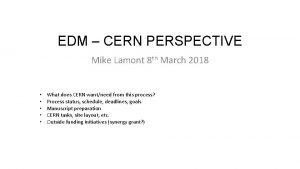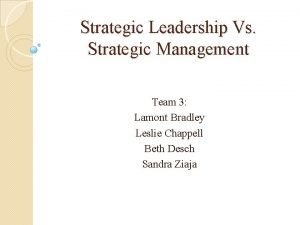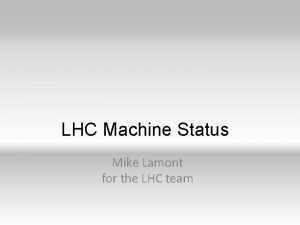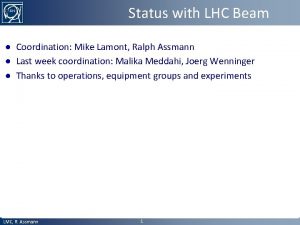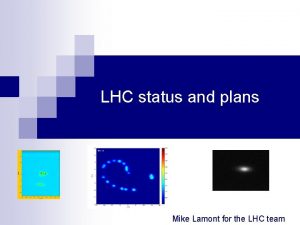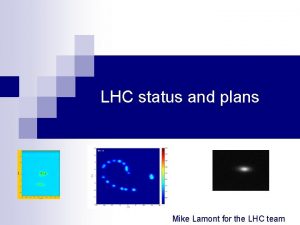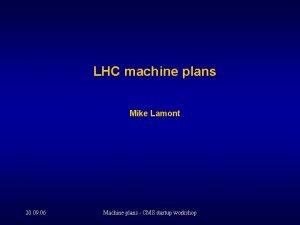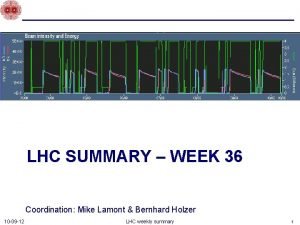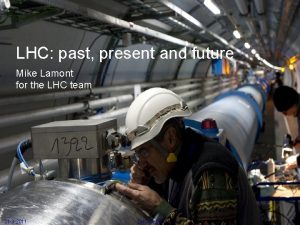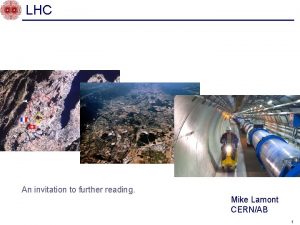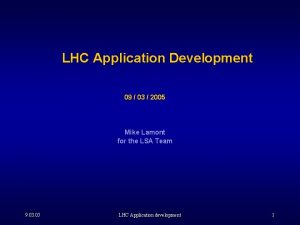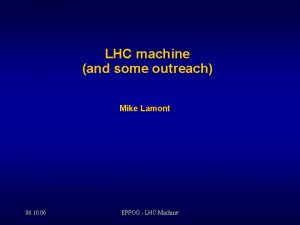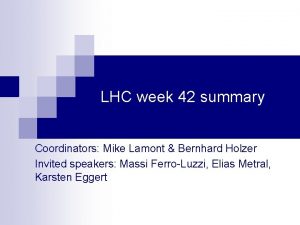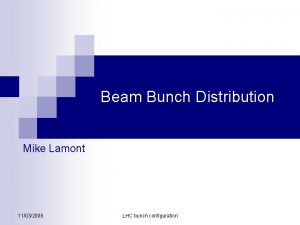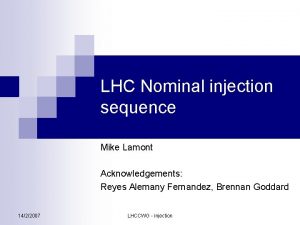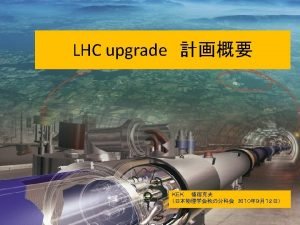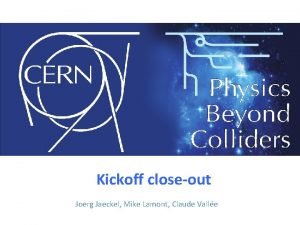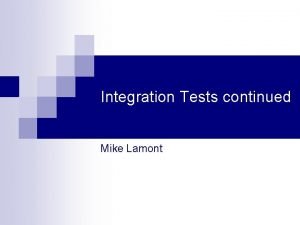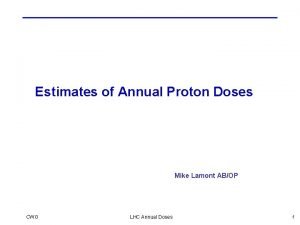LHC Status Mike Lamont for the LHC team






































- Slides: 38

LHC Status Mike Lamont for the LHC team

LHC - 2015 • Target energy: 6. 5 Te. V – looking good after a major effort • Bunch spacing: 25 ns – strongly favored by experiments – pile-up • Beta* in ATLAS and CMS: 80 to 40 cm Energy • Lower quench margins • Lower tolerance to beam loss • Hardware closer to maximum (beam dumps, power converters etc. ) • • • 25 ns Electron-cloud UFOs More long range collisions Larger crossing angle, higher beta* Higher total beam current Higher intensity per injection 2

Nominal LHC bunch structure 1 PS batch (72 bunches) 1 SPS batch (288 bunches) Abort gap • 25 ns bunch spacing • ~2800 bunches • Nominal bunch intensity: 1. 2 x 1011 protons per bunch 26. 7 km 2800 bunches 3

Beta* • Lower beta* implies larger beams in the triplet magnets • Aperture concerns dictate caution Image courtesy John Jowett βtriplet Sigma triplet β* Sigma* ~4. 5 km 1. 5 mm 55 cm 17 um

2015: beta* in IPs 1 and 5 • Start-up: β*= 80 cm – (very) relaxed – 2012 collimator settings – 11 sigma long range separation-> crossing angle – Aperture, orbit stability… looking good • Ultimate in 2015 and Run 2: β*= 40 cm – Validated during last machine development – Reduction later in the year not completely ruled out… 5

2015 commissioning strategy Ongoing 6

1. 6 x 1033 cm-2 s-1 5 th April first beam 10 th April: 6. 5 Te. V for the first time APRIL Finish magnet training MAY JUNE July 14 th: 476 b (50 ns) JULY 3 rd June: First Stable Beams JUL Y AUGUST August 23 rd 25 ns, 459 bunches 1 x 1033 cm-2 s-1 2015

Initial commissioning 1/2 • A lot of lessons learnt from Run 1 • Excellent and improved system performance: – Beam Instrumentation – Transverse feedback – RF – Collimation – Injection and beam dump systems – Vacuum – Machine protection • Improved software & analysis tools • Experience! 8

Initial commissioning 2/2 • Magnetically reproducible as ever • Optically good, corrected to excellent • Aperture is fine and compatible with the collimation hierarchy. • Magnets behaving well at 6. 5 Te. V – 11 additional training quenches • Operationally things well under control – Injection, ramp, squeeze etc. 9

Electron cloud When an accelerator is operated with small bunch spacing an Electron Cloud (EC) can develop in the beam chamber due to the Secondary Emission from the chamber’s wall. Dipole chamber @ 7 Te. V • Strong impact on beam quality (EC induced instabilities, particle losses, emittance growth) • Dynamic pressure rise • Heat load (on cryogenic sections) Giovanni Iadarola Electron bombardment of a surface has been proven to reduce drastically the secondary electron yield (SEY) of a material. This technique, known as scrubbing, provides a mean to suppress electron cloud build-up.

Scrubbing 2015 • E-cloud goes with bunch spacing – lot worse with 25 ns – more scrubbing required • Doublet scrubbing beam looked attractive… • A two stage scrubbing strategy was pursued: – Scrubbing 1 (50 ns and 25 ns) to allow for operation with 50 ns beams at 6. 5 Te. V – Scrubbing 2 (25 ns and Doublet) to allow for operation with 25 ns beams at 6. 5 Te. V 11

25 ns scrubbing - exit • Use of doublet beam difficult – more 25 ns scrubbing required • Present beam quality at 450 Ge. V OK for up to ~1500 bunches • Possible limitations from injection protection devices and injection kickers ~1200 bunches… 12

50 ns: 476 bunches – mid July Fill Stable beams /Lost 3992 5 h 18 m 476 3994 Top of ramp 476 UFO 10 L 3 3995 Flat top 476 UFO with quench, 34 L 8 3996 4 h 4 m 476 4000 Ramp 2. 0 Te. V 476 4001 69 s 476 4003 Ramp 2. 2 Te. V 476 4006 10 m 476 1. 6 0. 79 QPS board in B 16 R 1 4008 2 h 34 m 298 0. 9 7. 86 QPS board in B 29 R 2 4013 Ramp 6. 1 Te. V 476 RCS. A 78 B 2 earth fault 4015 Ramp 6. 2 Te. V 476 RCS. A 78 B 2 earth fault 4018 Flat-top 476 UFO 12 L 6 4019 31 m 476 bunches Peak Lumi 1033 cm-2 s-1 Int Lumi pb-1 dumped by 1. 4 22. 16 QPS RB. A 81 1. 6 20. 23 QPS board in B 29 R 2 UFO with quench at ULO 1. 4 <0. 1 QPS board in B 11. L 1 UFO at ULO 1. 5 2. 3 UFO 15 L 2 13

Initial 25 ns ramp-up – end August Fill Stable beams /Lost bunches Peak Lumi cm-2 s-1 Int Lumi pb-1 dumped by 41 xx Collisions 8 - - Earth fault S 78 41 yy 4201 Squeeze 8 - - Earth fault S 78 2 h 40 m 26 5. 9 e 31 0. 5 Water leak 4204 Flat top 86 - - Instability 4205 9 h 57 m 86 1. 732 5. 2 Programmed dump 4207 4 h 24 m 86 1. 6 e 32 2. 6 Electrical glitch 4208 5 h 12 m 86 1. 9 e 32 3. 0 UFO (plus quench) 4210 1 h 17 m 158 3. 6 e 32 1. 5 BPM interlock 4211 1 h 55 m 158 3. 8 e 32 1. 8 BPM interlock 4212 1 h 4 m 158 4. 5 e 32 1. 7 Cryogenics glitch 4214 5 h 16 m 158 4. 5 e 32 7. 4 Power converter trip 4219 6 m 219 6. 0 e 32 0. 1 RF trip 4220 10 h 16 m 219 6. 22 e 32 19. 3 OP dump 14

Initial 25 ns ramp-up – end August Fill Stable beams /Lost bunches Peak Lumi cm-2 s-1 Int Lumi pb-1 dumped by 4224 10 m 315 8. 3 e 32 Cryo MSR 8 4225 2 h 23 m 315 7. 7 e 32 Cryo MSR 8 4228 Squeeze 315 QPS SEU 4230 Adjust 315 RF trip 4231 5 h 26 m 315 4237 Flattop 315 4243 4 h 23 m 315 8. 3 e 32 12. 1 BPMS low intensity 4246 10 h 25 m 296 (50 ns) 1. 05 e 33 27. 0 OP dump 4249 19 m 459 8. 9 e 32 1. 0 QPS SEU S 81 4252 Ramp 459 4254 37 m 458 9/9 e 32 2. 1 Cryo comms 4256 2 h 18 m 458 1. 0 e 33 7. 7 UFO 19 R 2 4257 19 m 458 9. 6 e 32 1. 1 QPS SEU 6. 9 e 32 11. 1 QPS SEU S 34 QPS SEU L 1 QPS SEU 15

Main issues Intensity ramp-up designed to flush out intensity related issues – successful in that regard • Quench Protection System (QPS) – Non radiation hard components • Unidentified Falling Objects (UFOs) – Distributed around the ring • UFOs at the ULO – Appear to be suppressed by local warm-up of beam screen • Earth faults (not intensity related) – RCS. A 78 B 2 - 154 sextupole correctors on main dipoles – Main dipoles A 78 – intermittent fault 16

• 1268 modified boards used for special tests (CSCM) during circuit re-commissioning. • Replaced during last technical stop – things looking a lot better 17

UFOs A nice picture of some dust T. Baer CERN-THESIS-2013 -233 18

Accepted interpretation of a UFO event: 1. A macroparticle (dust) falls from the top of the beam screen 2. The macroparticle is subsequently ionized due to elastic collisions with the beam 3. The now positively charged macroparticle is subsequently repelled away from the beam 4. For the duration of the UFO-to-beam interactions, there may be significant losses due to inelastic collisions, resulting in a beam dump and or magnet quench! Typical “flight-path” diagram F. Zimmermann et al. IPAC’ 10 UFO simulation for a given mass, A. Scott Rowan

UFOs - strategy • No. of UFO events have been seen to exceed 10+/hour with notable increases after long shutdowns and or with a decrease in bunch spacing No. Arc UFOs/hour 16/hr • Beam loss monitor thresholds have been set judiciously • Essentially relying on conditioning (as observed above)

Aperture restriction in 15 R 8 ULO (Unidentified Lying Object) • Aperture restriction measured at injection and 6. 5 Te. V • Presently running with orbit bumps – -3 mm in H, +1 mm in V, to optimize available aperture • Behaviour with higher intensities looks OK • UFOs, DUFOs, MUFOs! D. Mirarchi 21

TDI (Injection protection devices) TDI: movable vertical absorbers – 4. 2 m in length – down stream of injection kickers TDI SEPTA KICKERS • Main blocks: hex-boron-nitride • However during bake-out tests… 22

TDI. R 8 • TDI h. BN block cannot withstand temperatures higher than 450 ◦C (B 2 O 3 reactant melting temperature) • Limitation on number of injection to avoid potential damage (maximum allowed temperature = 400 ◦C ) Limits of ~2 PS batches per injection (144 b) will reduce the maximum number of bunches to around 2400 in 2015 BN blocks to be replaced with graphite in YETS – temporary limitation 23

TDI beam 2 - vacuum • In addition during scrubbing, heating and outgassing of TDI right of point 8 has been observed – Vacuum spikes up to and above interlock limits 10 -6 mbar This could slow things down around 1200 bunches 24

To summarize • E-cloud – not fully scrubbed (it will get better) – Proving challenging for cryogenics at the moment • • • QPS – radiation to electronics issue resolved UFOs – to work though ULO – hope it stays quiet Earth faults – background worry TDI – to live with until YETS Painful for 2015 – a commissioning year – but they shouldn’t be long term issues for Run 2 25

Q 3/Q 4 2015 - latest 25 ns Pb-Pb

25 ns: after technical stop Since Sunday 6 th September until this morning Fill Stable beams /lost bunches Peak Lumi cm-2 s-1 Int Lumi pb-1 dumped by 4322 2 h 44 m 49 1. 3 e 32 1. 1 SIS BPM timestamp 4323 6 h 7 m 219 5. 4 e 32 10. 1 SIS BPM timestamp 4329 Adjust 459 4332 8 h 39 m 459 1. 1 e 33 26. 6 OP dump 4337 7 h 4 m 459 1. 1 e 33 22. 0 OP dump 4341 2 h 4 m 745 1. 73 e 33 11. 6 RF trip 4342 28 m 745 1. 77 e 33 2. 7 Cryo point 4 - regulation 4349 13 h 44 m 745 1. 72 e 33 66. 9 OP dump 4356 1 h 41 m 745 1. 59 e 33 8. 6 RF interlock 4360 4 h 25 m 745 1. 52 e 33 22. 3 Electrical glitch Cryo: Q 6 R 2 BS temp spike 27

30 September 2020 28

30 September 2020 29

Status today As of Monday 14 th September – 46 days proton physics left in 2015 • 745 bunches per beam, 1. 7 x 1033 cm-2 s-1 • Injecting 144 bunches per injection • Wrestling with e-cloud induced heat load on beam screens • Challenge for cryogenics to regulate with available cooling power • Next steps: 1100 – 1700 – 2300 (gently!) • SEUs, UFOs, ULO – look OK for the moment • TDI point 8 might start to be an issue around 1200 bunches – Beam induced heating and associated out-gassing – Looking reasonable at present 30

Performance… • Staying at 80 cm: 3 to 4. 5 fb-1 • Usual caveats apply – new regime – 25 ns, e-cloud, 6. 5 Te. V!!! 5 fb-1 Beta*=90 m 30 September 2020 31

Conclusions • 6. 5 Te. V/fundamentals look good • Commissioning and scrubbing went well – But still have significant electron cloud – will slow progress • Picked up some hang-over from LS 1 – – Quench protection system Earth faults Injection protection devices ULO • At the end of the day, the LHC is operational at 13 Te. V with 25 ns beam - this might regarded as an achievement for all involved. 2015 will be a short year for proton physics but should lay foundations for production for the rest of Run 2 and beyond 32

RESERVE 33

Serge Claudet • • • 24 km of superconducting magnets @1. 9 K 88 tons of superfluid helium at 1. 9 K 8 x 18 k. W @ 4. 5 K

35

Run 2 • EYETS – Extended Year End Technical Stop – 19 weeks – CMS pixel upgrade • Start LS 2 at the end of 2018 36

Run 2 performance • Start 2016 in production mode – – – 6. 5 Te. V, machine scrubbed for 25 ns operation Beta* = 40 cm in ATLAS and CMS New injection protection absorbers Peak lumi limited to 1. 7 e 34 by inner triplets Reasonable availability assumed – usual caveats apply – really need to gain experience with 25 ns operation Peak lumi E 34 cm-2 s-1 Days proton physics Approx. int lumi [fb-1] 2015 ~0. 5 65 3 2016 2017 2018 1. 2 1. 5 160 160 30 36 36 37

And beyond 3000 fb-1 Splices fixed Injectors upgrade New Low-β* quads 300 fb-1 30 fb-1 FG EPS 15 38
 Mike lamont
Mike lamont Mike lamont cern
Mike lamont cern Leadership vs management
Leadership vs management Donal lamont
Donal lamont Cafe lamont ballymena
Cafe lamont ballymena Mike and the battlefield team
Mike and the battlefield team Team spirit becomes team infatuation
Team spirit becomes team infatuation The white team cheers for the blue team, just like
The white team cheers for the blue team, just like Going native project management
Going native project management Särskild löneskatt för pensionskostnader
Särskild löneskatt för pensionskostnader Blomman för dagen drog
Blomman för dagen drog Borra hål för knoppar
Borra hål för knoppar Redogör för vad psykologi är
Redogör för vad psykologi är Lek med former i förskolan
Lek med former i förskolan Bris för vuxna
Bris för vuxna En lathund för arbete med kontinuitetshantering
En lathund för arbete med kontinuitetshantering Mat för idrottare
Mat för idrottare Etik och ledarskap etisk kod för chefer
Etik och ledarskap etisk kod för chefer Svenskt ramverk för digital samverkan
Svenskt ramverk för digital samverkan Indikation för kejsarsnitt på moderns önskan
Indikation för kejsarsnitt på moderns önskan Datorkunskap för nybörjare
Datorkunskap för nybörjare Plagg i rom
Plagg i rom Rita perspektiv
Rita perspektiv Ministerstyre för och nackdelar
Ministerstyre för och nackdelar Tack för att ni lyssnade bild
Tack för att ni lyssnade bild Claes martinsson
Claes martinsson Tillitsbaserad ledning
Tillitsbaserad ledning Nyckelkompetenser för livslångt lärande
Nyckelkompetenser för livslångt lärande Upprepning i prosa
Upprepning i prosa Tidbok
Tidbok Mästare lärling modell
Mästare lärling modell Matematisk modellering eksempel
Matematisk modellering eksempel Vilken grundregel finns det för tronföljden i sverige?
Vilken grundregel finns det för tronföljden i sverige? Verktyg för automatisering av utbetalningar
Verktyg för automatisering av utbetalningar Big brother rösta
Big brother rösta Bat mitza
Bat mitza Cellorov
Cellorov Urban torhamn
Urban torhamn Sju för caesar
Sju för caesar

